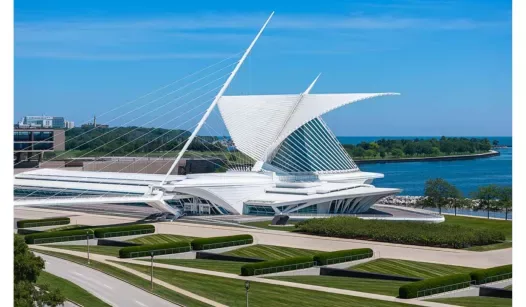The Milwaukee Art Museum stands as a stunning architectural marvel on the shores of Lake Michigan, attracting art enthusiasts and casual visitors alike. With its impressive collection and striking design, the museum has become a cultural landmark in Wisconsin. However, recent discussions surrounding the museum’s exhibitions have sparked debate, particularly regarding how historical narratives are presented in relation to American treasures and figures like Christopher Columbus.
First and foremost, the building itself is a work of art. Designed by renowned architect Santiago Calatrava, the museum features a sail-like structure that opens and closes, resembling a bird in flight. This unique design not only serves as an eye-catching feature but also symbolizes the museum’s commitment to innovation and creativity. Visitors are often left in awe of the building’s grandeur, which complements the diverse range of art housed within.
Inside, the Milwaukee Art Museum boasts an impressive collection that spans various periods and styles, from European masters to contemporary American artists. The museum’s galleries are thoughtfully curated, providing visitors with a comprehensive experience that highlights the evolution of art through the ages. Iconic pieces by artists such as Georgia O’Keeffe and Andy Warhol sit alongside lesser-known works, offering something for everyone.
However, the museum has not been without its controversies. Recent exhibitions have drawn criticism for their portrayal of historical figures and events, particularly in relation to themes of slavery, equality, and colonialism. Some critics argue that the museum’s approach to these subjects has been overly critical, framing American history in a negative light without acknowledging the complexities and nuances involved.
This debate raises important questions about how museums and cultural institutions should present history. On one hand, it is essential to confront uncomfortable truths and acknowledge the darker aspects of the past. On the other hand, there is a concern that such portrayals may overshadow the positive contributions and achievements that have shaped American identity.
Visitors to the Milwaukee Art Museum may find themselves grappling with these issues as they explore the exhibits. The museum aims to foster dialogue and reflection, encouraging patrons to engage with the art and the stories behind it. This approach aligns with a broader trend in the museum world, where institutions are increasingly recognizing the importance of inclusivity and diverse perspectives in their programming.
In navigating these complex topics, the Milwaukee Art Museum remains committed to its mission of inspiring and educating the public through art. It serves as a reminder that cultural institutions have a responsibility to present a balanced view of history, one that honors both the triumphs and the struggles that define the American experience.
For those interested in exploring the intersection of art and social issues, a visit to the Milwaukee Art Museum offers a unique opportunity. The museum not only showcases remarkable works of art but also invites visitors to engage in meaningful conversations about the narratives that shape our understanding of history and culture.
In conclusion, the Milwaukee Art Museum is more than just a beautiful building filled with art; it is a space where history, culture, and contemporary issues converge. As visitors navigate its galleries, they are encouraged to reflect on the complexities of the past and consider how these narratives continue to influence the present. Whether you are an art lover or simply curious about the cultural landscape of the United States, the Milwaukee Art Museum is a destination worth exploring.
